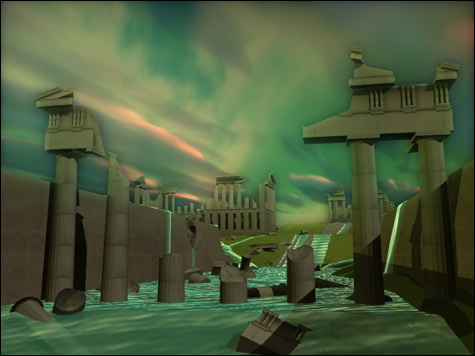
RISE AND FALL If the market drops, the weather could turn stormy in Children of Arcadia, at the Cambridge Arts Council. |
The installation Children of Arcadia convinced me that the 2009 Boston Cyberarts Festival isn’t going to suck. I’d been worried because I’ve seen lots of local cyberart (or new-media, or tech art, or whatever you want to call it) since the previous Cyberarts Festival, in 2007, and too much of it had been disappointing.
This work by artists exploring new technologies is one of the distinctive sectors of Boston art. It offers frequent exciting flashes of promise, and yet it often feels stuck in beta mode: full of bugs and half-assed ideas and not ready for full implementation. I should say that the stuff I’m most fascinated by — complex new programming and tinkerer/inventor–type works — is by its very nature slow and labor-intensive to produce. But too often new-media artists get so caught up in developing the new media that they don’t get around to developing the art.
Presented by Mark Skwarek, Arthur Peters, and Joseph Hocking at the Cambridge Arts Council (344 Broadway, Cambridge, through May 15), Children of Arcadia is an interactive computer simulation that allows you to roam a pastoral landscape of rolling hills dotted by towering trees, boulders, and classical ruins. (Their locations are pegged to the real-life New York Stock Exchange and other Manhattan landmarks.) The weather gets clear or stormy depending on the fluctuations of the stock market plus tallies of Google searches for “America + good” versus “America + evil.” There’s lots of lightning and thunder these days.
You can follow your avatar on a computer monitor, but that doesn’t affect anything, so it’s just about sightseeing (and, if you’re me, getting lost and bumping into invisible walls), which soon loses its appeal. The knockout gorgeous part — the part that restored my hope for this year’s Cyberarts Fest — is a 30x11–foot living digital panoramic “painting” of the entire scene that brings to mind American Thomas Cole’s The Course of Empire paintings, an allegorical depiction of the rise and fall of society (Rome as a metaphor for the US).
The Cyberarts Fest offers some 60 events spread across Greater Boston. So much is going on that perhaps only founder and ringmaster George Fifield is able to see it all. The fest has an open-source format: pretty much anyone who wants to put on a relevant show in town during the time period (it began April 24) is allowed to take part. The results are hit-or-miss. At its best, the fest benefits from the many and various visions of its contributors.
One of these bests is Tamiko Thiel & Teresa Reuter’s Virtual Wall/ReConstructing the Wall at the Goethe-Institut (170 Beacon Street, Boston, through May 6), an interactive digital simulation that allows you to explore either side of the Berlin Wall before it fell. This is an actual ghost town. Before your eyes, the city shifts forward and backward in time, a truck crashes through the gates and border guards shoot at it, the wall and the surrounding buildings rise or fall. (Bone up on Berlin Wall history before you go — the piece offers little context.) You can get arrested by border guards (cool), but the work is most riveting when you ascend to the top of a church tower and float like a spirit over the no-man’s-land scar between Cold War East and West.